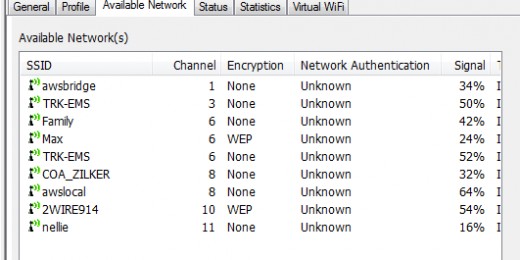- HubPages»
- Technology»
- Computers & Software»
- Computer How-Tos & Tutorials
External WiFi Antennas To Boost Signal Range
External WiFi Antenna




External WiFi antennas can be used to boost weak signals from a very long distance. One of the most powerful types of directional WiFi antennas is a grid parabolic. I recently experimented with one of these in Austin Texas, atop a high hill known as Mount Bonnell, located about four miles from downtown Austin.
In this test I used a grid parabolic external WiFi antenna, seen in the photo above, connected to a 200 mW wireless adapter. All of the gear that I used is available off the shelf. Many people use grid parabolic external WiFi antennas at each end of a wireless internet connection to extend its range out to several miles.
As I scanned the horizon of the distant city there were dozens of wireless networks displayed in the WiFi adapter's utility. I could turn the antenna just a fraction of a degree and pick up more. In the screen shot above is a screenshot of a tiny slice of the available connections I found. One of them is at the University Of Texas, which most likely has a number of directional or omnidirectional outdoor WiFi antennas aimed in various directions. I connected to the U.T. system from four miles away with no problem. Aiming the antenna a few degrees I found the city of Austin's free WiFi mesh system location, COA Zilker, and connected to it.
Many people who live on the fringe of free wireless internet mesh networks are finding that they can use external WiFi antennas like grid parabolic and panel antennas to connect for free. There are some FCC rules you need to be aware of, so as not to break the law. One is that the antenna and wireless adapter should fall within the guidelines of the table below.
To use the external WiFi antenna seen in the photo above, a WiFi Link 2.4 Ghz grid parabolic, you will need an external WiFi adapter that has an RP-SMA antenna connector, a length of coaxial cable with a reverse SMA type female connector on one end and and N type male on the other end. Your WiFi adapter should put out no more than 250 mW, since the gain of the antenna is 24 dBi. For this purpose the Engenius EUB-362 is perfect. This kind of external high gain WiFi antenna can be installed by the average person in about an hour. What takes time though is aiming the antenna for best performance. I suggest you take a laptop outside to where you have the antenna mounted on a pole or bracket and scan in all directions for the WiFi network you wish to connect to. Once you have achieved the best signal, lock down the nuts on the U bracket and you're done.
The chart seen above is for point to point applications, using directional antennas.









